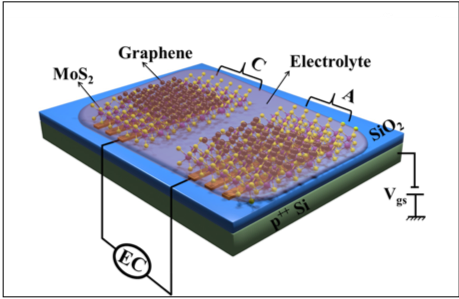The Indian Institute of Science (IISc) Department of Instrumentation and Applied Physics (IAP) has developed a new ultramicro supercapacitor, a tiny device that can store an enormous amount of electric charge. It is also significantly more compact and smaller than current supercapacitors and has the potential to be used in a wide range of products, including household gadgets, electric vehicles, streetlights, and medical equipment.
 Schematic of the device. Image Credit: Vinod Panwar and Pankaj Singh Chauhan
Schematic of the device. Image Credit: Vinod Panwar and Pankaj Singh Chauhan
Batteries currently power the majority of these devices. These batteries do, however, lose their capacity to hold a charge over time, resulting in a brief shelf life. The design of capacitors, on the other hand, allows them to hold an electric charge for a much-extended period of time.
A 5-volt capacitor, for instance, will keep running at that voltage even after ten years. However, they cannot continuously release energy like batteries can, for example, power a mobile phone.
Supercapacitors, on the other hand, are highly sought-after for use in the next wave of electrical products since they combine the best qualities of batteries and capacitors. They can store and also quickly release substantial amounts of energy.
Field Effect Transistors, or FETs, were used as the charge collectors in the current study, which was published in ACS Energy Letters, rather than the metallic electrodes found in existing capacitors.
Using FET as an electrode for supercapacitors is something new for tuning charge in a capacitor.
Abha Misra, Study Corresponding Author and Professor, Department of Instrumentation and Applied Physics, Indian Institute of Science
The electrodes used in current capacitors are usually made of metal oxide, but their electron mobility is weak. As a result, Misra and her colleagues chose to create hybrid FETs that have alternating few-atom-thick layers of molybdenum disulfide (MoS2) and graphene, which are then linked to gold contacts to enhance electron mobility.
To construct a solid-state supercapacitor, a solid gel electrolyte is placed between two FET electrodes. The entire structure is made of silicon dioxide/silicon base.
Misra added, “The design is the critical part, because you are integrating two systems.”
The two systems are the two FET electrodes and the gel electrolyte, an ionic medium with varying charge capacities. Vinod Panwar, Ph.D. student at IAP and one of the lead authors, stated that fabricating the device to achieve all of the optimal transistor characteristics was difficult.
Since these supercapacitors are so tiny, they can only be seen under a microscope, and the manufacturing process necessitates extreme accuracy and hand-eye coordination.
After fabricating the supercapacitor, the researchers evaluated its electrochemical capacitance, or charge-holding capacity, by applying different voltages. They discovered that under specific circumstances, capacitance rose by 3000%. Under the same conditions, a capacitor having only MoS2 and no graphene showed only an 18% increase in capacitance.
In the future, the researchers intend to investigate whether substituting MoS2 with other materials can raise the capacitance of their supercapacitor even further.
They added that their supercapacitor is fully functional and can be used in energy-storage devices such as electric vehicle batteries or any miniaturized system via on-chip integration. They also intend to file for a patent on the supercapacitor.
Journal Reference:
Panwar, V., et al. (2023) Gate Field Induced Extraordinary Energy Storage in MoS2-Graphene-Based Ultramicro-Electrochemical Capacitor. ACS Energy Letters. doi:10.1021/acsenergylett.2c02476.